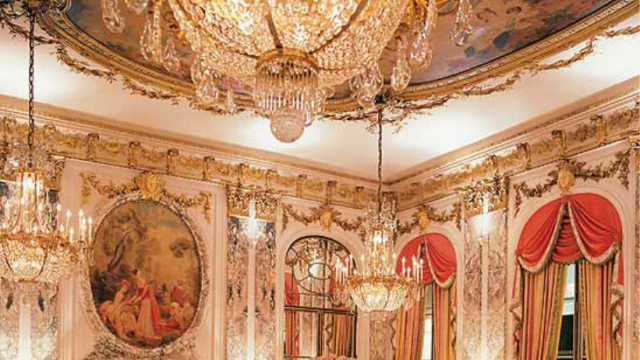Gold leaf, flowers, luminous light — an impression of sumptuous delicacy — as you contemplate your surroundings at the three-Michelin-starred restaurant of the hotel Le Meurice or meditate on the food on your plate.
For this is modern haute cuisine—one of the most pleasurable of all luxuries—to experience food that is not merely expensive, but so transformed that even with an army of servants, it could never be attempted at home.
With the menu comes the first amuse bouche—to tease the palate—a cocktail glass of gleaming red jelly is ceremoniously set down, swiftly followed by two tiny cups of foam in specially commissioned Limoges china. One foam is brown and earthy, the other snowy, like a beaten egg white. Clear and sharp, the radish jelly wakes your senses, offset by tiny nuggets of marshmallow and little crisp leaves. The first foam recalls a tapenade, an olive paste from southern France. But the white one, which is tomato, is the most surprising. It is ethereal—like inhaling the scent of the stem, an essence of a sunny tomato still on the vine. And the meal has barely begun.
The most beautiful of the great palace hotels of Paris, Le Meurice was founded in the 19th century after France had emerged from the rigours of revolution and an era of Napoleonic wars, coming to its present incarnation in the exclusive district of the 1st arrondissement. It was an exercise in nostalgia from its very inception, established as it was during a revival of the Bourbon dynasty that, it was said, had ‘learnt nothing and forgotten nothing’.
As a committed modernist, I had spent my youth ignoring the stuffiness of the grand hotels in the search for authentic provincial French cooking and the uncertain pleasures of nouvelle cuisine. Had I known that Salvador Dali frequented Le Meurice and dangled his lobster from the window to upset passersby, I might have tried to see if his ghost still walked.
I was floating my way through a surprise menu ‘degustation’—small tastings of many different dishes—and perhaps Dali’s spirit was present in the langoustine served three ways: a tail, a ravioli and a claw, each an exploration of taste and textures and each accompanied by puréed peas. One came with edible flowers, the next was a garden with tiny, cheeky shoots, and the third was paired with acidulated foam.
Japan was a rare foreign influence with hints of miso and wasabi in use. Although new techniques have been adopted across Europe, many involving much gadgetry and chemistry—so called ‘molecular gastronomy’—this is no culinary equivalent of the euro: each great chef not only plays with technique but pays close attention to the sourcing of excellent ingredients and exploring his native roots. For instance, the spirit that suffuses Le Meurice is not actually Dali’s but the light and decorative artistry of the 18th-century painters Watteau and Fragonard who flowered at the courts of Louis XV and XVI; Chef Yannick Alléno’s plates are homage not to Surrealism but to Rococo.
But if I was in any danger of missing French food as I used to know it, I was about to be reminded. A sauce ‘choron’, a béarnaise but using tomato as well as tarragon, appeared with salmon. Morels had already appeared, covered with gold leaf—a nod perhaps to all the gold leaf on the walls. They were cooked in a golden Jura wine and accompanied by a spinach leaf wrapped around tiny pieces of braised celery and bacon; it was deep, rich and delicious bourgeois food.
I put myself in the restaurant’s hands for a series of truly wonderful, judiciously poured, wines that were extremely reasonable compared to mark-ups in other countries. As a Côtes du Jura with an indefinable whiff of the farmyard followed a fragrant 2003 Condrieu, I began to rise out of the purgatory of too many New World wines. By the time we reached the white Châteauneuf du Pape bone dry as fine Manzanilla sherry, I had ascended to the choir of angels, celebrating the Rococo style in the blue painted ceiling.
And there I remained, out of body, slowly swirling a giant glass of Nuits St Georges as I embarked on the sole meat course: two cylinders of tender veal poached in a veal consommé, placed on a chewy risotto of ‘epautre’, an ancient type of cereal. These were accompanied again by the gold-leafed morels and another deep, intense, umami of a sauce.
The shock of a lemon sorbet brought me back to earth, along with small pungent chocolate, ginger macaroons and sent me into the world again from the palace hotel of France.
The food revolution of the last 30 years began outside the stuffy grand hotels. Those old bastilles have not been stormed so much as now subverted from within. No longer do you have to choose between being serious about luxury and serious about food. As Dante said, “My soul tasted that heavenly food, which gives new appetite while it satiates.”
Restaurant Le Meurice, Le Meurice, 228 rue de Rivoli, 75001 Paris (+33-1-44-581010, Three-course menu (lunch): 75 euro. Degustation menu (only dinner): 190 euro; with wines pairing: 320 euro




